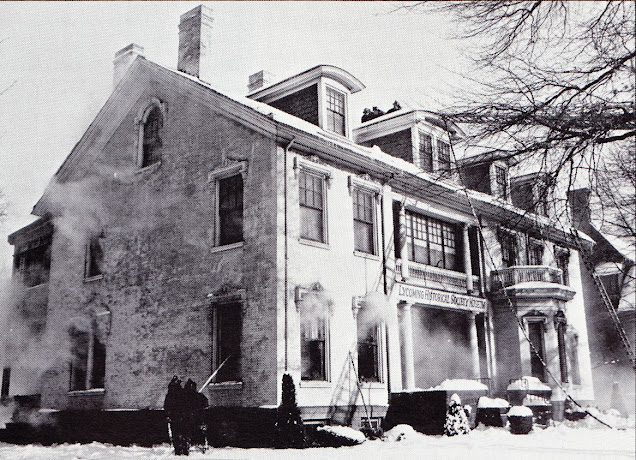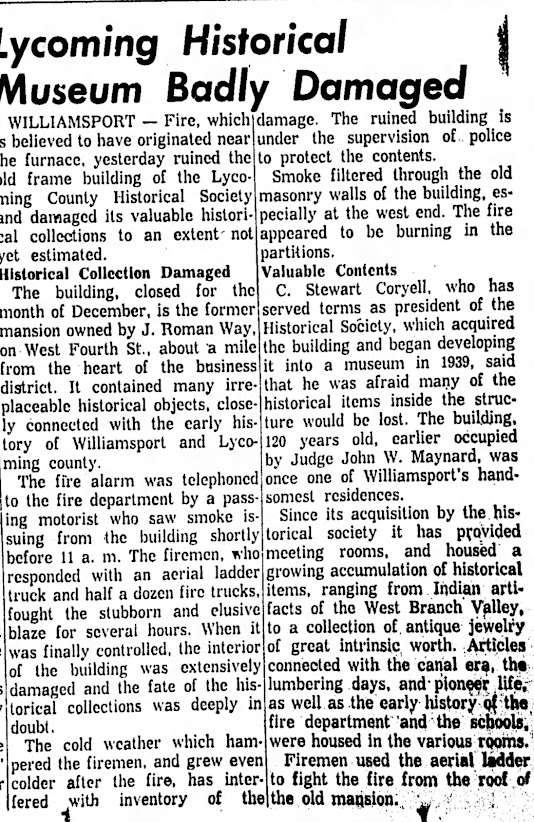The Society opened their first museum in 1941, in the historic home that formerly belonged to J. Roman Way. Way's park is today, located across from the museum
William Hepburn Farm
According to Lost Williamsport, the Judge John W. Maynard residence, built in 1840, was one of the few established homesteads west of town when Peter Herdic arrived in 1854. At this time, "west fourth street was still a narrow, dusty farm road." It was first owned by William Hepburn.
In 1884 the east side yard was given to Trinity Church by Maynard, to be used as the site of a new rectory.
Sometime in the 1870s, Judge John W. Maynard purchased the property and remodeled the home in a Gothic Revival Style.
Maynard added a gothic style tower and semicircular front walk. The bay window and tower covered the original front entry.
In 1913, J. Roman Way completed extensive renovations on the former Maynard house. Way remodeled the home here into a Colonial Revival Style - "removing the two side wings with cupolas and the Gothic-style crenelated tower and trim details". He removed two stories of the three story tower, and raised the entire house three feet on a new foundation.
Way then purchased White's castle, demolished it, and turned those grounds, visible out his front window, into a garden that he donated to the city.
J. Roman Way died in 1935. Sometime after that, the property was owned by Harry A. Gibson. In 1939 Gibson sold the property to the Lycoming Historical Society, which opened as a museum in March of 1941.
Lewisburg Journal March 1941
"At their open meeting on December 8, 1960, Historical Society members had met in
the museum's carriage house to celebrate the season with musical entertainment, storytelling,
and refreshments. In her minutes, the Board's secretary noted that:
"The carriage house was decorated beautifully with old fashioned Christmas trees, beautifully wrapped
packages, dolls, doll carriages, sleds. . . They served coffee and oodles of extra rich. delicious
Christmas cookies. l think everybody had a good time."
Thirteen days later, On December 21, 1960 - a fire destroyed the building.
Lycoming Historical Museum Bad/ WILLIAMSPORT — Fire, which is believed to have originated near the furnace, yesterday ruined the old frame building of the Lycoming County Historical Society and damaged its valuable historical collections to an extent not yet estimated. Historical Collection Damaged The building, closed for the month of December, is the former mansion owned by J. Roman Way on West Fourth St., about 'a mile from the heart of the business district. It contained many irreplaceable historical objects, closely connected with the early his lory of Williamsport and Lycoming county. The fire alarm was telephone to the fire department by a pass ng motorist who saw smoke is suing from the building shortly before 11 am.
The firemen, who responded with an aerial ladder truck and half a dozen fire trucks, "ought the stubborn and elusive blaze for several hours. When it was finally controlled, the interior of the building was extensively damaged and the fate of the historical collections was deeply in doubt. The cold weather which hampered the firemen, and grew even colder after the fire, has interfered with inventory of the damaged items. The ruined building is under the supervision of police to protect the contents.
Smoke filtered through the old masonry walls of the building, especially at the west end. C. Stewart Coryell, who has served terms as president of the Historical Society, which acquired the building and began developing it into a museum in 1939, said that he was afraid many of the historical items inside the structure would be lost.
The building, 120 years old, earlier occupied by Judge John W. Maynard, was once one of Williamsport's handsomest residences. Since its acquisition by the historical society it has provided meeting rooms, and housed a growing accumulation of historical terns, ranging from Indian artifacts of the West Branch' Valley, to a collection of. antique jewelry of great intrinsic worth. Articles connected with the canal era, the lumbering days, and-pioneer life, as well as the early history o| the fire department and the schools. were housed in the various rooms. Firemen used the aerial ladder to fight the fire from the roof of the old mansion.
=========================
After The Fire
=======================
After The Fire
=======================
In early August of 1961, papers throughout the region reported that the Ways Garden Commission had made an offer to Historical Society for them to build a new building in a corner of Way's Garden.
A week later, the Express reported that the historical society had rejected all bids to raze the museum, and instead had decided to allow the badly damaged and unusable building to stand for the time being.
It wasn't until May of 1964 that the society started to restore some of the items damaged in the fire.
The proposal to build a new building in Ways Garden was scrapped in 1965, when not enough money had been raised in the capital campaign. In 1968, the Pennsylvania Historical Commission presented the society with a $200,000 grant, allowing them to build a new cement building.
The new museum, which connects to the original carriage house, was designed by Frank A. Wagner. It was completed and opened to the public on November 22 1968.
================
READ MORE
=================
READ MORE
=================
"Most Successful Function In Appreciation of Donor Of Ways Garden" | The Castle That J. Roman Way Tore Down to Make A Garden Across from his home. |

















.jpg)


No comments:
Post a Comment
I'll read the comments and approve them to post as soon as I can! Thanks for stopping by!